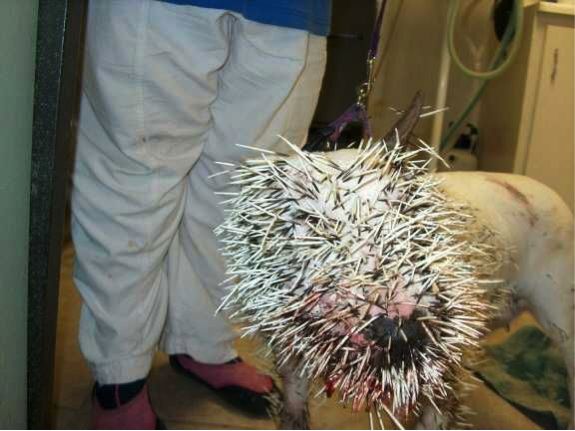As far as your pet is concerned, getting lost might be the most important issue you will ever face. Hopefully your pet will never get lost or otherwise separated from your side. In the event that somehow happens, hopefully you will have taken every precaution to aid in his safe return. To help avoid the heartbreak of a hopelessly lost pet, please give serious consideration to the following ideas and suggestions.
First, if you don’t already have one, get some type of identification tag (get one on Amazon or go to your local pet shop and pick one up – metal or plastic) with your name, your boat name, and a functional phone number on it (your cell number or a phone in your home country where a live person is likely to answer it – one phone call may be all your pet’s rescuer has the time or inclination to give). VISIBLE identification is the form most likely to get you and your pet reunited in the event of unexpected separation. And make certain the ID tag is firmly attached (via a good quality split ring) to your pet’s collar. Don’t be lackadaisical about this. Picture your pet running loose in a strange place and then picture that one person who might actually take the time to think that this pet looks like it could be lost; that person who might actually make an effort to bend over and look at your pet’s collar for a phone number! THIS IS IMPORTANT -MAKE IT EASY! That phone number has to be readily visible and it has to work in order for you and your pet to have a chance. The single biggest problem inherent in pet identification revolves around the fixed nature of a pet ID tag or collar and the limited amount of information it can provide. Being aboard a cruising boat or riding the roads in an RV, means that the best you can generally do is to provide your cell phone number or your e-mail address or even a phone number for a close friend or relative who is not traveling. But is that enough? What if they aren’t home when that call comes in, or what if the call goes to voice mail? Will it all end up in a frustrating game of long distance phone tag while your pet is running loose God knows where? Most good Samaritans are going to stop short of taking the pet home for an entire day or an overnight stay when they can’t even be certain that someone cares about the pet they’ve found.
Right now, the state of the art in pet identification is the electronic ID tag and the vast majority of people are completely unaware that it even exists! Electronic identification overcomes virtually all of the shortcomings of the engraved or written tag and the microchip. People are so unaware that a number of very efficient and potentially very effective ideas for electronic ID tags for pets have already come and gone. They disappeared due to poor design and poor promotion by their designers and an across the board general ignorance by the pet-owning public. As a result we are left with making do using the available items that are out there. This includes waterproof flash drives and QR tags.
For medium to large dogs, consider the Corsair Flash Survivor Stealth USB Flash Drive ($30.49 on Amazon) and for cats and small dogs, I’d suggest one of the smaller water-resistant flash drives, such as the all metal Raoyi Waterproof Metal USB2.0 Flash Drive ($6.49 on Amazon) or the GorillaDrive Ruggedized USB Flash Drive ($9.78 on Amazon).
Actually any of these (among others; there are a number of weatherproof metal flash drives with hooks, connectors, carabiners, and other forms of attachment available on Amazon if you just enter “waterproof flash drive” into the Amazon search box) flash drives will work on a dog (as long as it’s not a dog with a chewing fetish) of average size or larger, but you’ll need to check them out for size if you’re fitting a cat or small dog. They all look pretty durable. Whatever you choose to buy remember that none of them are completely indestructible. Don’t let your pet (or another pet in your household) chew on it; don’t let anybody beat the crap out of it, etc. And make certain the split ring (if necessary) that you attach it with is sturdy and ready to take a beating.
This type of device overcomes most of the limitations of the printed or engraved ID tag (not to mention your pet’s microchip, which we will discuss in a moment). For our intended use the flash drive only needs to hold a few megabytes of info to suffice, although most thumb drives now hold several to many gigabytes (far more capacity than you’ll ever use for this purpose). You can enter as much or as little information as you want, you can update the information as often as you need to, and the device can be read by anybody who might find it, providing they have access to a computer. Since it’s simply a computer flash drive, all they need to do is plug it into the USB slot of any computer and voila it’s all right there – pet name, contact information: your cell number, your mother’s home phone, your boat’s name, RV park, marina or anchorage location, the color of your boat or RV and any distinguishing characteristics, special needs, your upcoming itinerary, whatever you think might help somebody find you and get your cat or dog back where he belongs. You can even include your pet’s vaccination and critical health information. You can include files in both Word and PDF format if you choose, so that somebody doesn’t inadvertently damage a writeable file. Virtually any computer can read a word or a pdf file.
Visiting a non-English speaking country? Use a free online translation site to translate your information into French, Spanish, Portuguese, or whatever, and put that on there too; label it francais, español, or whatever so that a finder who does not speak English can recognize it. In this day and age, even in developing countries most people are familiar enough with computers to recognize a thumb drive when they see one. Even if the finder does not have a personal computer in his or her possession, most communities have places where one can go and rent or borrow time on a machine, such as a library, phone company office, or internet café. Not everybody everywhere has access to a microchip scanner, but this is the computer age and most people in most places are likely to have access to a computer. Give them the necessary information and make it as easy as possible to contact you and you are at least giving yourself and your pet a fighting chance. Just don’t get too carried away. Just because someone wants to get your pet back home does not mean they want to read your or your pet’s biography. My cat’s digital tag also includes, a written promise to any veterinarian willing to take him until I can retrieve him, that I will pay any and all charges associated with his rescue and protection.
Sample Text for Your Flash Drive Message
To whom it may concern:
Thank you so much for rescuing our dog, Max. Since you are reading this message, somehow Max has become separated from us. Max lives aboard our boat and he is like a member of our family. We are desperate to get him back. We live aboard a sailboat and we are presently cruising the islands of the Bahamas. We checked into the Bahamas in December with the intention of staying until May but we will now probably stay until we get Max back.
You can try to reach our daughter who lives in Maryland in the US. Please call her, collect if necessary, at 410-555-1234 or on her cell phone at 410-555-4321 and leave your phone number and a message stating that you have Max and are trying to contact us.
The name of our boat is the sailing vessel Second Wind. It is a white fiberglass catamaran and is 40 feet long. We normally anchor in harbors rather than visiting marinas.
If you have access to a high frequency or HAM radio, someone can contact the Cruiseheimers radio network any morning. The net starts at 8:30 AM and meets on the 8152 kHz frequency. Just break in and tell them why you are interrupting.
Please feed and take care of Max for us until you hear back from us. We will gladly reimburse you for all expenses associated with his care and his return to us. If you cannot keep him, please take him to a veterinarian or a shelter along with this flash drive so that they can try to reach us.
Message #2:
To whom it may concern: Thank you for saving me. I am lost. My name is Maxwell and I live aboard a boat with my owners. They are probably frantic because I am missing. The boat is a sailboat and its name is Desperation. My owners are anchored out in Dakity Bay here in Culebra. You can call them on a VHF radio by calling “Second Wind, Second Wind.” If they don’t answer, please make a general call on the VHF telling people that you have found me and need to contact my owners aboard Second Wind.
If you cannot reach anybody, please at least place a call to my owners’ daughter Jeannie in Maryland. Call her at 410-555-1234 or on her cell phone at 410-555-4321 and leave your phone number and a message stating that you have Maxwell and are trying to contact them. Please don’t let me go until you have found my owner. They will gladly reimburse you for any expenses.
These drives are supposedly tough and/or waterproof but I would be leery of placing a metal ID tag on the pet’s collar adjacent to the device unless the device is somehow protect, e.g. wrapped in tape, or similarly protected.
My cat’s digital tag does include a written promise to any veterinarian willing to take him until I can retrieve him, that I will pay any and all charges associated with his rescue and protection.
We’ll talk more about flash drives and such below, but here and now let’s discuss the other practical option that you have available for electronic protection of your pet, the QR tag. We have all seen QR codes in number of places, from products we buy, to billboards and the sides of vehicles. Even election candidates are starting to include QR codes on their junkmail campaign mailings. The QR code is that little (or sometimes big) square box with all the pixelated-looking gobbledygook inside the square. You simply point your phone at the code (with a free QR code reading app installed) and the code will connect you to a website where you will find more information, or in the case of your pet, the scanner will reveal your personal contact information which you had previously uploaded when you got the tag. These tags are available, often for less than $10 and range from tags that are specifically for use on pets to those intended for just general purpose identification use, such as on luggage. You buy the tag, go to the associated website and, often at no charge, sign up for inclusion in their database, providing all of the information needed to get your item (or your pet) returned. Check out the pet-specific combination QR tag from CNATTAGS that serves double duty with an engraved name and address on one side like a traditional pet ID tag, and a QR code on the backside – a truly great idea. There are also pet-specific QR tags from Dynotag, Red Dingo , PetDwelling , and others. Or you can order up a set of general purpose tags from Dynotag. Just remember to check if the purchase price includes free lifetime registration. I think that on most of these brands, that is the case.
(A special note to those of you living and cruising aboard boats (and also, to some extent, RV’s) when using a flash drive for identifying your pet:
As an example, if you are cruising aboard a yacht in the Bahamas, your flash drive should say so and might offer your intended itinerary. Not only should it give contact information for someone in your home country, it should also instruct the person finding the dog to contact the Cruiseheimers HF radio network. Tell them the daily time and frequency for the net and how they can break in and give the net your boat name and the pet’s return information. Cruiseheimer listeners, if they have the information, will seek you out even if you don’t have a HF radio aboard. These are the kinds of things that no conventional pet tag or microchip can do.
(Other cruising locales have similar regional HF radio nets that you might utilize, such as the Caribbean Safety and Security Net or even Chris Parker’s Caribbean weather net. [See cruiserswiki.org] Some popular cruising destinations also have local VHF nets. Thisis the sort of emergency that just about anybody is eager to help with.)
A couple of minor points worth mentioning: I would not offer a reward or make mention of anything more than reimbursement of expenses. If someone is concerned enough to take the tag and read your message, they will probably expend the necessary time and energy trying to contact you without any further incentive. You don’t want to come across as a wealthy yacht owner and turn a generous humanitarian gesture into some kind of extortion attempt. After the pet is returned, you can then (and you really should) express your gratitude any way you choose
Remember that you as a cruiser take your lifestyle for granted and tend to forget that most people have no idea whatsoever that people might actually live aboard boats and travel the oceans. Even in the U.S. normal people (after all, we can all completely agree on this – cruisers are not “normal people”) do not give this much thought. Inthe Caribbean, the average person on the street, unless he/she specifically deals with cruisers, generally assumes that you are from a resort or a cruise ship, not a private yacht. If someone finds your pet, it is important that they know the situation. And there is still no better insurance than a leash. Do not think of a leash as some kind of restriction or punishment. It’s your pet’s lifeline. Use it!)
Keep the above discussion for liveaboard cruisers in mind if you are a land cruiser living in a motorhome. You may very well be able to modify these ideas to fit your special needs.
If you are more into lowtech (i.e. not your typical cruiser) at least put some sort of small, waterproof container (A small zip-lock baggie attached to the collar with wire ties would work.) on the pet’s collar containing a paper or card with as much information as possible to help get your pet back in the event it becomes lost. Just like with the flash drives, you should include personal information, boat or RV information, home contact information, (how about a boat card or personal card?), etc. – everything and anything that might help – particularly a functioning e-mail address and a textable phone number that will reach you wherever you happen to be. This option is far inferior to the above devices, but it’s still better than nothing.


